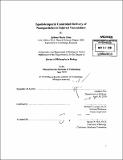| dc.contributor.advisor | Robert S. Langer. | en_US |
| dc.contributor.author | Chan, Juliana Maria | en_US |
| dc.contributor.other | Massachusetts Institute of Technology. Dept. of Biology. | en_US |
| dc.date.accessioned | 2010-09-02T17:24:14Z | |
| dc.date.available | 2010-09-02T17:24:14Z | |
| dc.date.copyright | 2010 | en_US |
| dc.date.issued | 2010 | en_US |
| dc.identifier.uri | http://hdl.handle.net/1721.1/58290 | |
| dc.description | Thesis (Ph. D.)--Massachusetts Institute of Technology, Dept. of Biology, 2010. | en_US |
| dc.description | Cataloged from PDF version of thesis. Vita. | en_US |
| dc.description | Includes bibliographical references. | en_US |
| dc.description.abstract | Complex multimodal nanoparticles (NP) that target and deliver therapeutic agents to a site of disease are a promising direction in modem medicine. As a starting point for innovation, we designed a hybrid NP system combining the benefits of liposomes and polymeric NPs. These particles have a polymeric surface which displays targeting ligands while avoiding macrophage uptake. A liposome-like layer provides in vivo biocompatibility and a hydrophobic core allows for high-capacity small molecule drug delivery. Targeting ligands that bind injured vasculature were discovered and optimized by screening an M13 bacteriophage library (109 independent clones) against collagen IV, the major component of the basement membrane. Relative binding affinities using ELISA identified the lead targeting candidate, which bound with 900-fold greater relative affinity to collagen IV when compared with the unselected library. The selected peptide sequence was synthesized and tested for its ability to actively target the hybrid NP system. Paclitaxel, an anti-proliferative drug, was chosen as the delivered pharmaceutical. Drug release was modified through a slow-eluting paclitaxel conjugate using controlled ester hydrolysis (drug release -10-12 days in vitro). To test these targeted NPs, injured vasculature was approximated using an aortic smooth muscle culture embedded on a collagen IV matrix. In this setting, the hybrid NPs showed clear evidence of increased potency using the selected ligands. In experimental animal models of surgery-induced vascular injury, targeted NPs showed a four-fold improved retention at angioplastied aortas over intact aortas ex vivo. Targeted NPs were tested as intraarterially delivered therapy to angioplastied carotid arteries in vivo and showed a two-fold better localization at injury sites versus scrambled-peptide and non-targeted NPs. Targeted NPs were also tested using a systemic, intravenous infusion administered postprocedure on Day I and 6 and resulted in lower neointima-to-media (N/M) scores at two weeks compared to FDA-approved Taxol@ and injury-only groups (N/Msham= -249 + 0.046, vs. N/MTaxol=0.837 ± 0.087, N/MNP=0.749 ± 0.136 and N/MPep-NP=0.662 ± 0.169, all P < 0.01 vs. injury-only, mean ± SEM, n=5). These findings indicate that complex, multilayered NPs can functionally target and treat injured vasculature, a clinical problem of primary importance. | en_US |
| dc.description.statementofresponsibility | by Juliana Maria Chan. | en_US |
| dc.format.extent | 173 p. | en_US |
| dc.language.iso | eng | en_US |
| dc.publisher | Massachusetts Institute of Technology | en_US |
| dc.rights | M.I.T. theses are protected by
copyright. They may be viewed from this source for any purpose, but
reproduction or distribution in any format is prohibited without written
permission. See provided URL for inquiries about permission. | en_US |
| dc.rights.uri | http://dspace.mit.edu/handle/1721.1/7582 | en_US |
| dc.subject | Biology. | en_US |
| dc.title | Spatiotemporal controlled delivery of nanoparticles to injured vasculature | en_US |
| dc.type | Thesis | en_US |
| dc.description.degree | Ph.D. | en_US |
| dc.contributor.department | Massachusetts Institute of Technology. Department of Biology | |
| dc.identifier.oclc | 654107403 | en_US |
